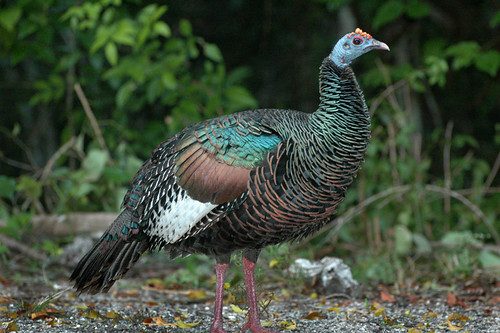With Thanksgiving come and gone and millions of pounds of turkey consumed, given to the dogs and thrown out I figured it would be appropriate to pay a little homage to turkeys today.
There are two species of wild turkey, the ocellated turkey (Meleagris ocellata), from the Yucatan Peninsula, and the wild turkey (Meleagris gallopavo) from North America. Domestic turkeys descend from the wild turkey and though there appear to be a large number of breeds of domestic turkey they are technically all the same breed, just different varieties. Ocellated turkey, from: http://farm4.static.flickr.com/3075/2325795822_c290ddc1a3.jpg
Ocellated turkey, from: http://farm4.static.flickr.com/3075/2325795822_c290ddc1a3.jpg
Ocellated turkeys are quite lovely, I hadn't heard of them until tonight. In 1993 the National Wild Turkey Federation sponsored research on the ocellated turkey. They found that this species is found in only a 50,000 square mile area, encompassing the Yucatan Peninsula, northern Belize and the El Peten region of Guatemala. Male and Female ocellated turkeys are similar in appearance, both have blue heads with orangish nodules, though males have a fleshy blue crown behind the snood that is covered with more nodules; both birds have bronze and green iridescent feathers, females often appear more green; neither sex has a beard and their breast feathers do not indicate sex; and both sexes have blue-bronze eye-shaped spots on the end of their tails, followed by a gold tip. During the breeding season males have a red ring around their eyes and larger spurs than North American wild turkeys. Ocellated turkeys live in diverse habitat types, from arid brushlands to marshlands, to second growth forests, to rain forests. Their diet includes grasses, mint-like herbs, and small seeds, insects and fruit. Hens lay 12 eggs in the period starting mid-March and ending in late-May. Poults hatch in early-May to mid-June.  Wild turkey, from: http://www.statesymbolsusa.org/IMAGES/Massachusetts/wild_turkeyTOMpgc.jpg.
Wild turkey, from: http://www.statesymbolsusa.org/IMAGES/Massachusetts/wild_turkeyTOMpgc.jpg.
Wild turkeys are native to North America, except for Alaska, north to Ontario, Canada. By the early 20th century wild turkeys were extirpated from the northeastern United States. Reintroduction programs across the east have been successful. Domestication of the turkey began in Europe in 1500, when wild turkeys were brought back to Europe from Mexico. Domesticated birds were brought back to the United States by European colonists. Birds decending from the first domestic birds are similar to wild turkeys but have a white band at the tip of their tail that is not present in other wild subspecies. Benjamin Franklin is known for having desired the brave turkey to be nominated the nation's symbol rather than the "cowardly" bald eagle. More information is available here and here.
Domestic turkeys come in a dazzling array of colors and patterns. Broad-breasted whites are the most common domestic breed. This variety of turkey has been bred to have so much additional muscle mass that they can no longer breed without human intervention. Another common (though not as common as the whites) domestic breed is the broad-breasted bronze. Heritage breeds are not as common as the white and bronze but they are pretty awesome either way. Some of the more common heritge breeds are the spanish black, standard bronze, bourbon red, slate (the light version of which is called lavender) and the Narragansett. Currently, my mom has a pair of Lavenders that I adore, Freyja spent the weekend playing with them. Lavenders are registered as critical by the American Livestock Breeds Conservancy (listing breeds of livestock as critical or threatened is a little bizarre to me but that's another post entirely). All heritage species are listed as needing to be watched, threatened or critical, none are listed as recovering. In the past we've had a variety of breeds, including Narragansett's, I've seen Royal Palms (another heritage breed) and I'd like to see the bourbon reds in person. For more information about domestic turkeys go here.
Taylor, C.I.; Quigley, H.B.; Gonzalez, M.J. Ocellated Turkey (Meleagris ocellata). National Wild Turkey Federation, Wildlife Bulletin No. 6, 8pp. Available at: http://www.nwtf.org/all_about_turkeys/history_ocellated_wild_turkey.html> Accessed November 30, 2008.
Wikipedia. Domestic Turkey. 2008. Available at: http://en.wikipedia.org/wiki/Domesticated_turkey> Accessed November 30, 2008.
National Wild Turkey Federation. All About Turkeys. 2008. Available at: http://www.nwtf.org/all_about_turkeys/index.html> Accessed November 30, 2008.
Sunday, November 30, 2008
Ethno-ornithology Sunday: Thanksgiving style
Posted by Bird Wicks at 10:10 PM
Labels: ethno-ornithology
Subscribe to:
Post Comments (Atom)

4 comments:
6:34 am never did i think id be talking turkey so early,thanks for the info.
whoa cool turkey...go yucatan!
packli
All the same breed just different variety....crazy
Good Morning my Little Bird, As your mother and poultry judge I am proud to see the understanding of "one breed" many "varieties" mentioned in regard to the domestic turkey! Thats my girl! Really enjoyed the infomation on the occelated (sp?)turkey as well. Have a good day! Madre
Post a Comment